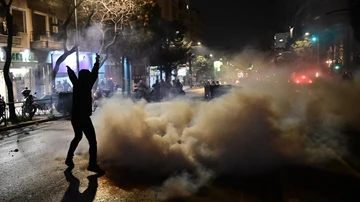While those who died from train crash in greece continues to rise, the railway employees’ unions have announced a 24 hour strike this Thursday due to the deterioration of the sector and to criticize that the only detainee is an employee of the state train company.
The death toll from the collision of two trains that occurred on Tuesday night north of Larissa in central Greece now stands at 42, while search teams continue to try to locate bodies in the remains of the railways.
The firefighters are focusing their tasks on the third car of the passenger train, where yesterday They recovered several lifeless bodies. Meanwhile, workers on the railways and in the Athens metro have announced a 24-hour strike on Thursday denouncing “the chronic lack of respect shown by the different governments” to the railway sector, which, they say, “led to the tragic result”. Tuesday.
Citizen discontent, however, is also reflected in a protest that took place last night outside the offices of Hellenic Train in Athens, the company that operates the railways in Greece.

Greek riot police fire tear gas at protesters in front of the Greek Parliament. | Europe Press
Hundreds of protesters accused the government for the privatization of the company in 2017while there were also various altercations when a group threw Molotov cocktails at the Police, who responded with tear gas.
The incident occurred shortly before midnight on Tuesday local time (22:00 GMT), when two trains, one with 342 passengers and 10 railway employees and another cargo with two drivers, collided near the small town of Tempe, about 300 kilometers from Athens.
At least 57 people remain hospitalized, six of them in intensive care. Many of the victims were young university students returning to Thessaloniki after a festive long weekend.
According to the Greek newspaper Kathimerini, all the people in the ICU are young people between 21 and 26 years old. This Thursday will appear before the prosecutor’s office Larisa Station Manager, a 59-year-old man who, according to local media reports, acknowledged that erred when he placed the passenger train on the same track as the freight train was traveling in the opposite direction.
Greece’s railways, Hellenic Train, are operated by the Italian state company Ferrovie dello Stato Italiane. The passenger train covered the Athens-Thessaloniki route, while the commercial train, which probably transported sheet metal, covered the Thessaloniki-Athens route.
Source: Lasexta
Ricardo is a renowned author and journalist, known for his exceptional writing on top-news stories. He currently works as a writer at the 247 News Agency, where he is known for his ability to deliver breaking news and insightful analysis on the most pressing issues of the day.












